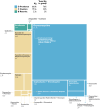National-Level Consumption of Antimicrobials in the Veterinary Sector in Uganda: A Report on Analysis of Import Data for 2021
- PMID: 40001394
- PMCID: PMC11852167
- DOI: 10.3390/antibiotics14020150
National-Level Consumption of Antimicrobials in the Veterinary Sector in Uganda: A Report on Analysis of Import Data for 2021
Abstract
Background: Antimicrobials are crucial for animal health and food security. However, their overuse in animals can lead to the emergence of resistant microorganisms. Antimicrobial resistance (AMR) poses a global public health threat that impacts both animal and human health. The objective of this study was to estimate the antimicrobial consumption (AMC) of veterinary antimicrobials at the national level using import data from January to December 2021, available from the Uganda National Drug Authority (NDA).
Methods: The World Organization for Animal Health (WOAH) methodology was applied using the Anatomical Therapeutic Chemical classification codes for veterinary medicines.
Results: Approximately 88,387.37 kg (88.39 tonnes) of veterinary antimicrobials were consumed in 2021. Parenteral veterinary antimicrobials accounted for 63.8% (56,375.65 kg) and oral veterinary antibacterials accounted for 36.2% (32,011.71 kg). Tetracyclines were the single most consumed veterinary antimicrobial class, accounting for 62.7% of total consumption. Oxytetracycline was the most consumed antibacterial (58.4%), followed by sulphadiazine + trimethoprim (11.1%), penicillin g/dihydrostreptomycin (7.4%), penicillin G procaine + dihydrostreptomycin (6.8%), and tetracycline (3.5%), respectively. Out of all imported veterinary antimicrobials, 76% belonged to the World Health Organization (WHO)'s Highly Important Antimicrobials (HIA) category, 16% to the Critically Important (CIA), and 9% to the Highest Priority Critically Important (HPCIA) categories. Imported colistin accounted for 0.1% of total veterinary consumption.
Conclusions: This study contributes to understanding antimicrobial consumption in Uganda's livestock sector and, for the NDA, leaves in place a system for routine surveillance at a national level. We recommend strict regulatory oversight on the importation and use of colistin and macrolides to address AMR.
Keywords: Africa; Uganda; antimicrobial consumption; antimicrobial resistance; antimicrobial use surveillance; veterinary antimicrobials.
Conflict of interest statement
Authors Helen Byomire Ndagije, Diana Nakitto Kesi, Allan Serwanga and Mark Barigye were employed by the National Drug Authority. The remaining authors declare that the research was conducted in the absence of any commercial or financial relationships that could be construed as a potential conflict of interest.
Figures
Similar articles
-
National consumption of antimicrobials intended for use in animal livestock health: a retrospective data analysis of antimicrobial imports to Uganda from 2018 to 2020.BMC Vet Res. 2025 Apr 4;21(1):248. doi: 10.1186/s12917-025-04709-9. BMC Vet Res. 2025. PMID: 40186221 Free PMC article.
-
Antimicrobial consumption surveillance in Uganda: Results from an analysis of national import data for the human health sector, 2018-2021.J Infect Public Health. 2023 Dec;16 Suppl 1:45-51. doi: 10.1016/j.jiph.2023.10.029. Epub 2023 Oct 31. J Infect Public Health. 2023. PMID: 37926595
-
Ethiopian antimicrobial consumption trends in human health sector: A surveillance report 2020-2022.PLoS One. 2025 Feb 28;20(2):e0319295. doi: 10.1371/journal.pone.0319295. eCollection 2025. PLoS One. 2025. PMID: 40019905 Free PMC article.
-
Antimicrobial resistance in food-producing animals: towards implementing a one health based national action plan in Israel.Isr J Health Policy Res. 2023 Apr 26;12(1):18. doi: 10.1186/s13584-023-00562-z. Isr J Health Policy Res. 2023. PMID: 37101188 Free PMC article. Review.
-
Antimicrobial Resistance and Its Impact on Food Safety Determinants Along the Beef Value Chain in Sub-Saharan Africa-A Scoping Review.Trop Med Infect Dis. 2025 Mar 20;10(3):82. doi: 10.3390/tropicalmed10030082. Trop Med Infect Dis. 2025. PMID: 40137835 Free PMC article. Review.
Cited by
-
Advancing Nigerian Indigenous Poultry Health and Production, Use of Probiotics as Viable Alternatives to Antibiotics: A Review.Antibiotics (Basel). 2025 Aug 21;14(8):846. doi: 10.3390/antibiotics14080846. Antibiotics (Basel). 2025. PMID: 40868040 Free PMC article. Review.
References
-
- Iskandar K., Molinier L., Hallit S., Sartelli M., Hardcastle T.C., Haque M., Lugova H., Dhingra S., Sharma P., Islam S., et al. Surveillance of antimicrobial resistance in low- and middle-income countries: A scattered picture. Antimicrob. Resist. Infect. Control. 2021;10:1–19. doi: 10.1186/s13756-021-00931-w. - DOI - PMC - PubMed
-
- World Health Organization (WHO) Global Action Plan on Antimicrobial Resistance. 2015. [(accessed on 7 January 2024)]. Available online: https://www.who.int/publications/i/item/9789241509763.
Grants and funding
LinkOut - more resources
Full Text Sources



